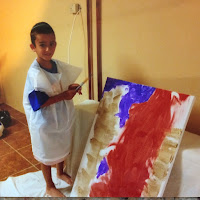Wouldn't it be lovely to have a magic mirror that could honestly evaluate our strengths and weaknesses? Self-awareness is so hard to achieve. In a way though, we actually do have such a mirror. We learn a lot about ourselves by the ways in which people respond to us. Part of growing up is figuring out who we are how we fit into the world, and we get much of that information from the caring adults in our lives. Children know how we feel about them and what we think of them, regardless of the words we use. They intuit our true thoughts and feelings. Our eyes are magic mirrors that reflect who they are.
I interviewed many potential teachers when I was an early childhood director. One question I learned to omit from the interview was, "Why do you want to teach young children?". The answer was always "Because I love children". Unfortunately, this statement is meaningless. Most everyone claims to love children, but what does that really mean? Sure kids can be adorable, and affectionate, and funny and cute, and make us feel needed. But they can also be mean and rude and defiant and hyperactive and messy. They test our patience and can make us feel incompetent. Loving a child isn't about saying it or even feeling it; it's about our actions. Loving a child means working very, very hard to understand what her behaviors are communicating to us; to reach deep within ourselves for all the patience and positivity we can muster to get her through this stage, then the next. I used to tell my teachers that they would not fall in love with every child in their class, but that every child had some lovable qualities, and it was their job to identify, appreciate, and build on those qualities. It's no easy task, but it's the only way that children can learn. They need to know, deep in their bones, that we really care for them.
One day a prospective teacher was giving a model lesson to a toddler class. A little boy in that class had been presenting behavior problems; frequently hitting the other children, pulling their toys away, and even biting. The teachers, parents, and I were working together to identify his needs and help him learn better behavior. At the model lesson, the prospective teacher asked each child his/her name. This little boy said, "I'm Connor (not his real name) and I'm a bad boy". My heart dropped to my feet. I'm sure no one ever told him that, but he felt it. He understood that he was attracting a lot of negative attention, and as wonderful as his teacher was, it was only human for her to feel the need to gird her strength day after day, paste on a happy face and try to manage this child's antics. On some level, he caught all that.
Children can sometimes misinterpret our reactions. How many times have you heard a child say, "My teacher hates me." This is surely an exaggeration, as anyone capable of hate is certainly incapable of teaching. Nevertheless, the child is probably sensing something and it would be a good idea to contact the teacher and hear her thoughts. At home, one of my daughters was convinced that every time I became angry at her I stopped loving her. She would wail, "Mommy hates me!". It took lots of one-on-one time and conversation for her to believe that I loved her no matter what. Even if she did a bad thing and even if I was very angry, she was my precious child and I still loved her. Behaviors can be bad; but children are not. It's important to separate the behavior from the inner-self. I wanted my daughter to know that there was nothing she could ever do to make me stop loving her.
These examples show how exquisitely sensitive children are to the feelings of adults . It's not terrible for them to see our disappointment or even anger. Disappointment shows that we know they can do better. Anger, as long as it is controlled, can even serve as an important teaching tool. Children see that anger is a normal human emotion, and that the speech or behavior that prompted it is deeply offensive. By observing how we behave when we're angry, children can learn ways to manage their own angry feelings.
I've heard it said that eyes are the window to the soul. I personally believe that children are almost like angels. They're so new to the earth, and haven't yet sinned. Maybe that's why they can look into our eyes and read us like a book. For their sake, I continue to work on myself, so that when a child looks into my eyes all he sees is love and kindness.















